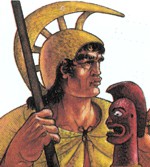 |
THE TIMES OF KAMEHAMEHA THE GREAT |
 |
THE TIMES OF KAMEHAMEHA THE GREAT |
In 1984 a deck was made by the Regensteiner Printing
Enterprises from Chicago. They made the films and plates and did the printing on
card from Watervlete, Michigan. The finishing touch (cutting the round corners,
sealing and packaging) was done at Arrco in Chicago.
The deck was published on Hawaii as a souvenir deck with an
historic perspective and it comes with a leaflet, which is titled "The
Times of Kamehameha The Great, 1753- 1819". In the leaflet the deck is
described as "Fragments of Hawaii's History Playing Cards". So that
may well be the official title of the deck itself.
The deck was designed by Joseph Feher and he also wrote the leaflet, describing the depicted persons, flora and fauna, and
the illustrations of everyday life, which can be found on the 6's and 2's. The
following information about the artist was taken from the Joseph Feher website:
Joseph Feher was born on April 23, 1908, in Miscolz,
Hungary, and attended the Royal Academy of Fine Arts and Teacher’s College in
Budapest. He also studied on scholarships at the Academy Bella Arte In Florence,
Italy, and also the Bauhaus in Germany. In 1928, he came to the United States,
and was a scholarship student at the School of the Art Institute of Chicago. He
then embarked on a career in commercial art and portraiture, and also taught at
the Chicago Art Institute, and the Institute of Design. He first came to Hawaii
in 1934 on a leave of absence, and spent a year painting in the Puna District of
the Big Island of Hawaii. He returned to Chicago, but eventually settled
permanently in the Hawaiian Islands in 1947.
In that same year, he started a 40 year career with the Academy of Arts in
Honolulu teaching at the art school. During that time, he was also employed
part-time by United Airlines, who sent him to the continental United States,
painting watercolor scenes of different cities for their advertising campaigns
and travel calendars until about 1949.
In 1955 Feher worked on a project at the Bishop Museum as an artist-historian
for his book, "Hawaii: A Pictorial History," which included many of
his own illustrations, and was finally published in 1969. He became the editor
and designer of "the Conch Shell," a quarterly published by the Bishop
Museum from 1963 to 1968. During his career at the Bishop Museum, he spent many
years doing illustrations for other countless books and publications. He loved
drawing and painting Hawaiiana, and his illustrations showed much passion for
the subject.
In the mean time, he continued teaching at the Art School of the Honolulu
Academy of Arts, and became the school’s director in 1962. He served as
Curator of Prints for the Academy from 1971 to 1981, and Senior Curator from
1973 to 1987. He designed the Academy’s publications and the museum’s
familiar logo.
Feher designed the Hawaii Statehood Commemorative Postage Stamp in 1959, and
redesigned the state seal of Hawaii. He was chosen to attend the New York
World’s Fair in 1964 to display the Bishop Museum’s Hawaii exhibit.
Among many graphic arts awards received throughout his career, Joseph Feher has
been the recipient of Distinctive Merit Awards from the Annual Art Directors
Exhibition, Medal Awards from the Chicago Art Directors Annual Exhibition, and
Award Certificates from the National Offset Lithography Competition and the
Society of Typographic Arts, and many other prestigious awards. Joseph
Feher died in June of 1987, at the age of 79.
When an artist, a teacher and a passion come together in one
person, it can only result in a deck like this. Of course I'm not sure, but I
think that it isn't very likely that there were historical portraits of these
ancient Hawaiian chiefs. Still the artist managed to create some very convincing
portraits on the figures and at the same time show some of his considerable
knowledge of and passion for the historical Hawaiian objects, already in use
before the days of Kamehameha I.
In the accompanying leaflet we meet the teacher Joseph Feher. We'll quote from
the introduction.........
"During the life of Kamehameha the Great, 1753 - 1819, important events influenced Hawaii's destiny. Starting with Capt. Cook's discovery of the islands in 1778. Hawaii was opened up to visitors from foreign lands, which brought foreign ideas and changes to the people of Hawaii. The personalities close to Kamehameha who are featured on the cards as Kings and Queens were directly affected by the changes. The foreign influences also modified the functions and authority of the Kahunas, pictured as Jacks. Kahunas were experts in their roles and crafts as priests, artist-carvers, medical practitioners, house builders, canoe makers, etc."

The King of Spades depicts Kalanikupule. He was the
King of Oahu. He's wearing a feather helmet and cloak, holding a spear. In 1794
he was captured and sacrificed after the conquest of Oahu by Kamehameha I.
The Queen is Keopuolani, the sacred wife of Kamehameha I and mother of
Kamehameha II and III. She's wearing a feather "leis" in her hair and
around her neck and she's holding a small branch of the "Ohia Lehua"
tree. She died in 1824.
The Jacks show professionals of some importance. A Kahuna Kalai is a
carving expert and sculptor. He's holding a stone "adz", the principal
tool for carving and is wearing a "Kapa Kihei" (wrap) and a "maili"
crown.
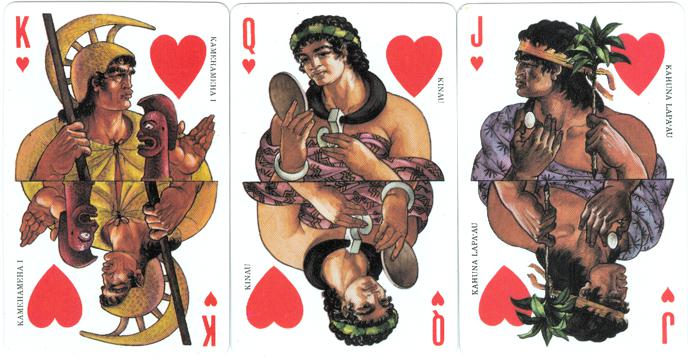
The King of Hearts shows Kamehameha I. He was probably
born in 1753 and in 1794 he conquered all the islands, established a Kingdom and
became the King of all Hawaii. He's wearing a feather helmet and cloak, holding
his spear. In front of him is "Kukailimoku", his feather war god.
The Queen isn't his wife, but his daughter Kinau. She reigned from 1832
until her death in 1839. She's holding a mirror of polished stone and is wearing
a necklace of the "lei niho palaoa", reserved only for the chiefly
class.
The Kahuna Lapa'au is a medical doctor. Here he's holding a chicken egg
and a "ti" plant branch, both utilized in the process of healing. His
hair is tied with a strip of "kapa".
The Ace of Hearts shows the principal food plants, like
breadfruit, yams, banana, coconut, kukui nut and "taro".
The Ace of Clubs shows reef fauna and flora, that also provided food: shells,
molusks, urchins and seaweed.
The Ace of Diamonds shows some of the food fishes, like "Aweoweo",
"Ahi", "Nukunuku" and "Kihikihi".
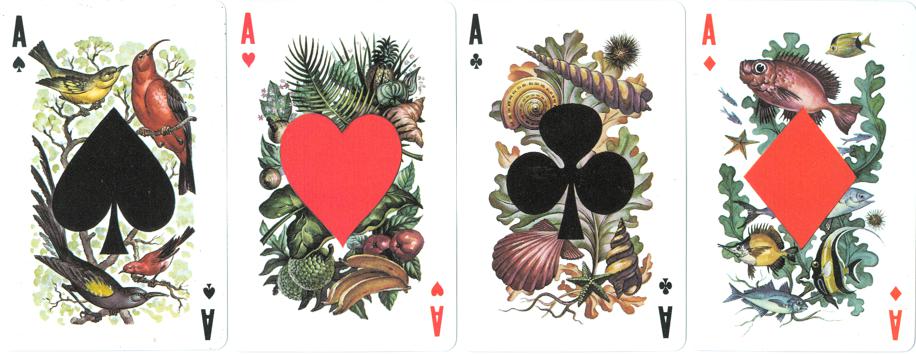
The Ace of Spades shows birds. The "Amakihi", "I'íwi", "O'o" and "Apapane". They and other birds provided the feathers, that were used in the making of feather cloaks, capes and helmets. Feather works also included "leis" and god images. It doesn't say in the description, but it's not hard to imagine that they too were food providers, once they had been stripped of their feathers. CLICK THE ACES TO SEE THE PIPS PER SUIT.

The King of Clubs represents Kaumualii, who was King
of Kauai and joined the Kingdom in 1810. He's wearing a "mushroom"
ornamented wicker helmet and feather cloak, holding a spear.
The Queen of Clubs shows Kaahumanu. She was the favorite wife of
Kamehameha I. She lived from 1768 to 1832 and reigned the Kingdom from 1819
until her death. Here she's depicted wearing a "lei niho palaoa" and
holding a small "kahili", made of feathers.
On the Jack a Kahuna Ki'i. He was the caretaker of images, responsible
for the safe-keeping and preservation of the carved images. He's wearing a
"maile lei".
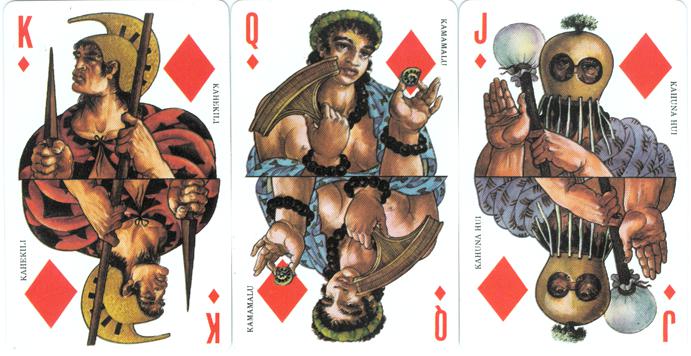
The King of Diamonds shows Kahekili, King of Maui. He
died in 1794, when his fleet of double canoes was defeated by Kamehameha I in a
naval engagement.
Kamamalu is the Queen of Diamonds. She was the wife of Kamehameha II and died in
1824. She's wearing a "lei" and bracelet of of polished kukui nuts,
has a feather "lei" in her hair and holds a fan made of coconut frond
midribs.
The Kahuna Hui on the Jack is the priest who conducts the ceremonies for
the deification of a King. He's wearing a gourd mask and holding a "Kapu"
stick (sign of prohobition). His helmet of concealment is decorated with ferns
and "Kapa" strips.
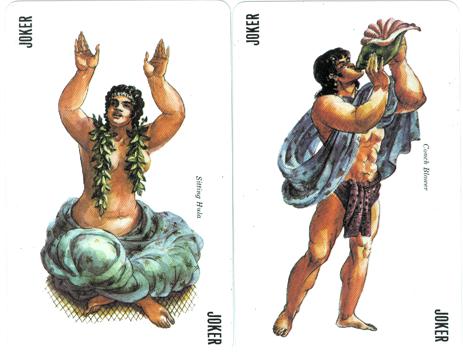 |
Sitting Hula. Dancing the hula was performed in standing or sitting positions. Conch Blower. Shell trumpets were used at various occasions. The sound was heard as far as two miles. |
|
|
The deck and leaflet come in a plastic box.